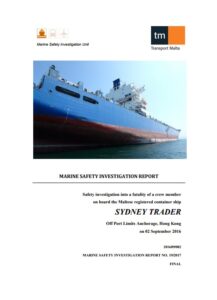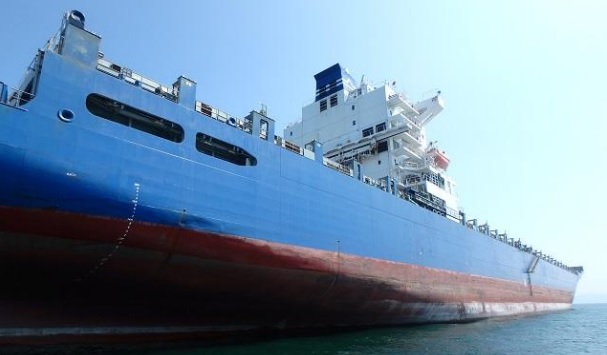The Marine Safety Investigation Unit issued an investigation report on the fatality of a crew member on board the Maltese registered container ship Sydney Trader, off Port Limits Anchorage, Hong Kong, in September 2016. The report provides a description of what happened and safety conclusions.
The incident
The Maltese registered container vessel Sydney Trader had been anchored OPL at Hong Kong, China since 19 June 2016, awaiting orders for the next charter. At 0730, on 02 September 2016, the chief mate instructed the bosun to continue routine maintenance work in cargo hold no. 2. The chief mate also confirmed that all the Safety Management System (SMS) risk assessments and Permit to Work forms had been completed and signed before the bosun left the bridge at 0750.
At about 0805, five crew members entered cargo hold no. 2 via the manhole aft of Bay 18, Row 4, no. 2 M hatch, above the middle cross section. Soon after, at about 0810, the bosun reported to the chief mate that one of the ordinary seafarer (OS) had fallen down cargo hold no. 2. The bosun also informed the third mate (duty officer) on the bridge. The master was informed of the accident at about 0815.
The chief mate proceeded immediately to the cargo hold to provide first aid and medical assistance. When reaching the tank top, he noticed that the OS was unresponsive, with a serious head wound. He checked for a pulse on the OS’ hand and neck but could not detect any.
Probable Cause
The immediate cause of the fall from platform no. 2 was not witnessed by any of the crew members inside the cargo hold. It was evident, however, that the fall was not arrested by the safety wire, which parted under the weight of the fatally injured crew member.
Conclusions
- It was not excluded that the OS may have either leaned on the safety wire, possibly putting his full weight on it to look down to the cargo hold tank top, or lost his footing after descending the ladder, grabbing the safety wire tosteady himself causing it to fail.
- The potential failure of the safety wire had not been identified as part of the vessel’s safety management system.
- The failure of the safety wire was due to a combination of a weakened safety wire due to severe corrosion of the strands, possible due to the daily exposure to and penetration of natural elements.
- The corroded safety wire strands would have reduced the overall tensile strength of the safety wire.
- The fact that the safety wire was sheathed and considering its location inside the cargo hold, made it susceptible not to be inspected and replaced.
- It would have been virtually impossible for the crew members to determine the extent of the (internal) corrosion damage within the safety wire strands.
- The very same sheathing which was fitted to protect the safety wire had actually served to conceal a lethal problem, which led to the ultimate failure of the safety wire.
- It would seem that the safety wire was accepted because it was fitted during the ship building, without an actual objective analysis as to why this physical barrier system, rather than another, had been selected.
- The failure of the safety wire cannot be attributed to a systemic failure of the vessel’s safety management system.
- Fatigue was not a contributing factor to this accident.
Recommendations
Lomar Deutschland GmbH is recommended to:
- replace all safety wires, considering that these safety barrier systems are an intrinsic part of the on board safety;
- apply a definite life-cycle to the safety wires and address this in the vessel’s safety management system and the related planned maintenance regime to ensure that all safety wires inside the cargo holds are replaced at regular intervals
Explore more by reading the full report:



































































